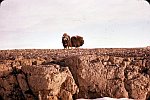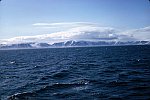The Northern Eco-System
Author: Curt McManus Page 1 | Page 2 | Page 3
Caribou and musk ox represent some of the other larger mammals who live in the Northern world. The name caribou, by the way, is derived from the Micmac word meaning “pawer” or “shoveller” because it was erroneously thought at one time, that the Caribou used the shovel shaped antlers on it’s forehead to dig at the ground.
The other-wordly looking Musk-ox, like Polar Bears, often reside in the High Arctic regions, like Banks Island on the edge of the Arctic Ocean where a recent head-count found some 60,000.
Caribou, like most other animal life serve an important function in the overall eco-system. They serve as food for lower and smaller forms of animal life which abounds in the northern regions. The antlers of Caribou are apparently rich in calcium and other essential minerals and so beings as lowly as the ground squirrel often feed upon the decaying antlers of dead Caribou.
The arctic is full of smaller forms of animal life. The Eider duck, for example, makes its improbable home in the farthest reaches of the High Arctic. The pictures below were taken on Devon Island.
And yes, the Eider duck is the bird which provides the essential stuffing for pillows, blankets and assorted comforters. The “down” (seen in above photo of nest) in Eiderdown are the soft feathers plucked from the breasts of female Eider’s with which the ducks line their nests. Innu harvest the ‘down’ after nesting chicks are gone. It takes some 60 nests to make two pounds of down, and it can sell for $600-$700 per pound. The Eider duck is also one of the main sources of food for a bird which is sometimes called the “thug of the arctic”.
The Jaeger is an aggressive hunting bird. It raids nests, chases and kills lemmings, gobbles tiny little tundra birds and even steals food from the mouths of other birds. It is not surprising to learn that a) the Jaeger is a relative of the sea-gull and b) ‘Jaeger’ is the German word for hunter.
In fits of over-confidence, the Jaeger has even been known to swoop and attack foxes, wolves, caribou and musk-ox. But, objectionable though the Jaegers behavior might be, it is one more way in which the arctic eco-system continues to function.
The world of arctic plant life is almost as exciting as the animal world. Take the Lichen for example. It is one of the more intriguing plants of the algae-fungi family. There are over 1,000 different varieties of Lichen in the North, some of which can be more than 1,000 years old.
A Lichen is a growth, really; a barely animate organism which hopelessly attaches itself to completely inanimate objects. Rocks, fossilized antlers, and dead tree stumps are just some of the places the Lichen calls home. Lichens, though, like Jaegers, have their fans because in High-Arctic regions lacking in varieties of vegetation, sometimes it is the only the Lichen that seems to thrive and survive. The Lichen can sometimes be the only splash of color in an otherwise colorless landscape. Naturalist Wayne Lynch calls Lichens “the foot soldiers or unsung heroes of the tundra environment.” Swedish taxonomist Carolus Linnaeus, no doubt affectionately, called the Lichen “the poor trash of vegetation.” Indeed, the Lichen retains an obscure, somehow endearing quality if one can get passed its ridiculousness.
Whatever its deficiencies in intrigue, the Lichen serves a couple practical and vital functions, like many other plants and animals of the Northern Eco-system. First, this hardy fungus is generally the first vegetation to appear in the tracks of retreating glaciers. And second, because it is very sensitive to air quality, Lichens are used by scientists to gauge pollution and air quality. 19th century explorers who found themselves lost in the High-arctic found a third use for Lichens. Famished explorers, it seems, ate Lichens which sadly induced fits of nausea and diarrhea.
Lichens can be justifiably placed at the head of the long list of flora which abounds
in the arctic climate. Below are some examples of the wide variety of plant life
which exists in one of the most challenging environments on the planet.
Cotton grass, pictured above, is much the same as the dandelion found in southern Canada. Its “fluff” is carried by the wind and in this way it perpetuates itself and so the weed is found all across the North. The “fluff” of cotton grass was also used at one time as starter for seal-oil lamps. This gentle plant exists on the farthest fringes of the High Arctic and so goes its own distance in debunking the myth that the north is a frozen wasteland.
The natural world in which the above plants and animals exist and thrive, is not pleasant by any standards, especially southern standards. But bear in mind, there is only one element which makes the North substantially different than other areas of the country: the cold. From this one element most of the differences and peculiarities of the north develop. It should also be remembered that cold itself is not a “presence”, but rather a lack of heat energy. Cold occurs when there is insufficient heat energy. Cold is a blank; cold is a void; it is nothingness. That “nothingness” is powerful and governs the conditions in the arctic environment. For example, frost, a by-product of the cold, has the power to shatter rock and wear away mountains.

























